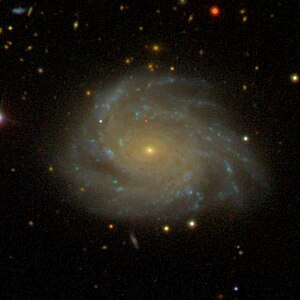NGC 3780
| Galaxy NGC 3780 |
|
|---|---|

|
|
| SDSS recording | |
| AladinLite | |
| Constellation | Big Bear |
|
Position equinox : J2000.0 , epoch : J2000.0 |
|
| Right ascension | 11 h 39 m 22.3 s |
| declination | + 56 ° 16 ′ 14 ″ |
| Appearance | |
| Morphological type | SA (s) c: / LINER |
| Brightness (visual) | 11.5 likes |
| Brightness (B-band) | 12.2 mag |
| Angular expansion | 3 ′ × 2.4 ′ |
| Position angle | 90 ° |
| Surface brightness | 13.5 mag / arcmin² |
| Physical data | |
| Affiliation | LGG 247 |
| Redshift | 0.008002 ± 0.000017 |
| Radial velocity | (2399 ± 5) km / s |
|
Stroke distance v rad / H 0 |
(111 ± 8) x 10 6 ly (33.9 ± 2.4) Mpc |
| history | |
| discovery | William Herschel |
| Discovery date | April 14, 1789 |
| Catalog names | |
| NGC 3780 • UGC 6615 • PGC 36138 • CGCG 292-014 • MCG + 09-19-150 • IRAS 11366 + 5632 • 2MASX J11392237 + 5616146 • GC 2476 • H I 227 • h 929 • 2MASS J11392235 + 5616144 • LDCE 867 NED031 | |
NGC 3780 is a spiral galaxy with an active nucleus of the Hubble type Sc in the constellation Great Bear in the northern sky . It is estimated to be 111 million light years from the Milky Way and about 95,000 light years in diameter.
The galaxy NGC 3794 is located in the same area of the sky .
The supernovae SN 1978H (Type-II) and SN 1992bt (Type-IIP) were observed.
The object was discovered by Wilhelm Herschel on April 14, 1789 .
NGC 3780 group ( LGG 247 )
| Galaxy | Alternative name | Distance / million Lj |
|---|---|---|
| NGC 3780 | PGC 36138 | 111 |
| NGC 3888 | PGC 36789 | 111 |
| PGC 36836 | UGC 6774 | 110 |
| PGC 36000 | UGC 6596 | 105 |
Web links
Commons : NGC 3780 - collection of images, videos, and audio files
